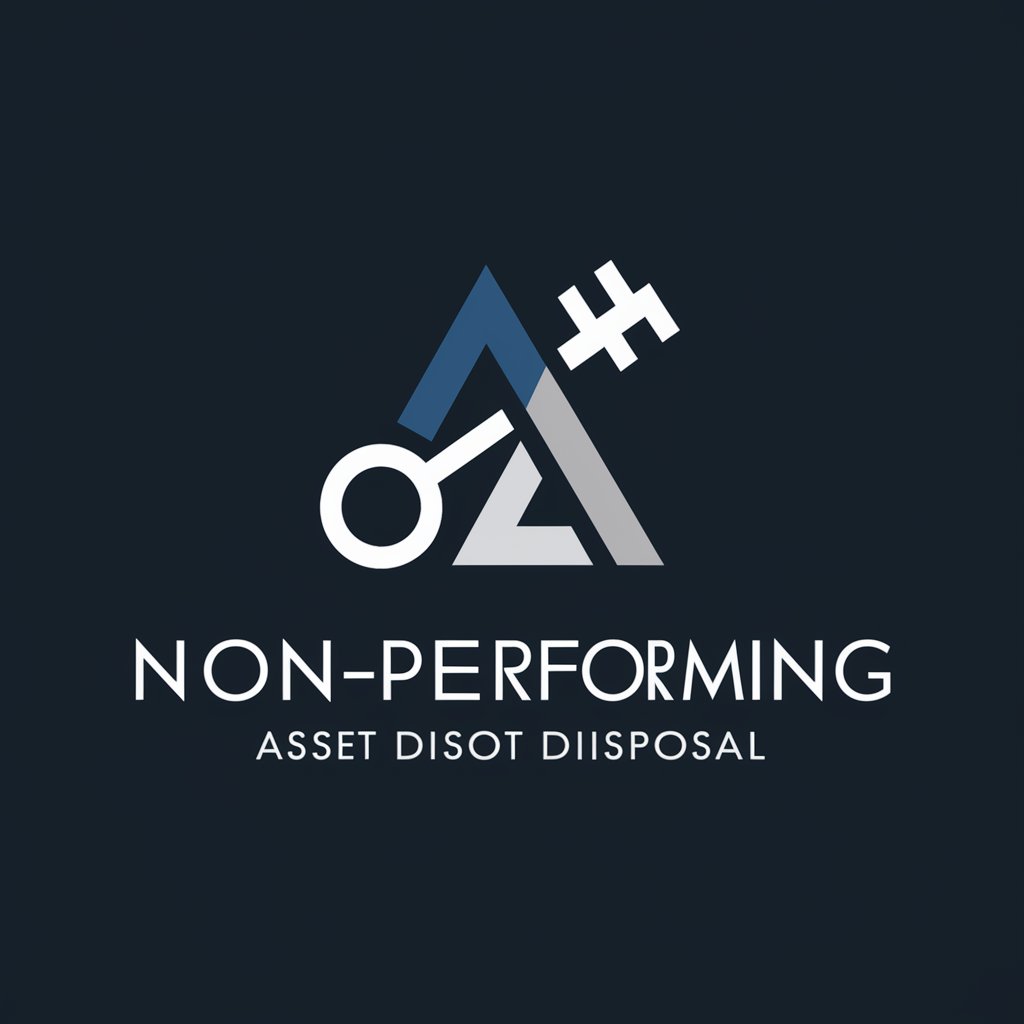不良资产处置策略 - AI-powered Asset Disposal

Welcome! How can I assist you with non-performing asset strategies today?
Streamlining Non-Performing Asset Solutions
Can you explain the best strategies for managing non-performing loans in a...
What are the legal considerations when disposing of distressed assets in...
How can financial institutions minimize losses from non-performing assets through...
What role does market analysis play in the successful disposal of...
Get Embed Code
Introduction to 不良资产处置策略
不良资产处置策略, or Non-Performing Asset Disposal Strategies, is a specialized service designed to offer expert, technical advice on the disposal and management of non-performing assets (NPAs). Its core objective is to provide actionable strategies that institutions, corporations, and individuals can use to effectively reduce the financial impact of assets that are not yielding expected returns. This encompasses a broad spectrum of assets, including but not limited to, defaulted loans, properties acquired through foreclosure, and any investment that fails to generate anticipated income. By utilizing a combination of financial analysis, market insight, and legal frameworks, 不良资产处置策略 facilitates the recovery process and aims to maximize returns from these underperforming assets. Examples of its application include the restructuring of loan terms to improve repayment feasibility, the sale of assets to interested buyers through auctions or private sales, and the conversion of assets into more profitable ventures. Each strategy is tailored to the specific nature of the asset and the financial goals of the asset holder. Powered by ChatGPT-4o。

Main Functions of 不良资产处置策略
Asset Valuation and Analysis
Example
Assessing the current market value of a foreclosed property and predicting its future value trends.
Scenario
A bank holds several properties acquired through foreclosure. 不良资产处置策略 provides a detailed analysis of each property's market value, considers the impact of market trends, and advises on the optimal timing for sale to maximize returns.
Debt Restructuring and Negotiation
Example
Renegotiating the terms of a loan for a corporation struggling to make payments.
Scenario
A manufacturing company faces cash flow issues and is at risk of defaulting on its loans. 不良资产处置策略 devises a restructuring plan that extends the loan's maturity, reduces the interest rate, and negotiates grace periods with creditors, thereby enabling the company to recover financially and avoid asset liquidation.
Asset Disposal and Monetization
Example
Selling non-performing loans to a third party at a discount.
Scenario
A financial institution has a portfolio of non-performing loans that are tying up capital. 不良资产处置策略 advises on packaging these loans and selling them to a specialized investment fund at a discount, thus freeing up capital for new, profitable lending opportunities.
Ideal Users of 不良资产处置策略 Services
Financial Institutions
Banks, credit unions, and other lenders that have accumulated non-performing loans or foreclosed properties. They benefit from 不良资产处置策略 by efficiently converting these assets into cash or more profitable assets, improving their balance sheets and financial health.
Corporate Clients
Companies facing liquidity issues or possessing unprofitable assets. Through 不良资产处置策略, these entities can restructure their debts, negotiate better terms, or dispose of non-core assets, aiding in their financial recovery and operational restructuring.
Investment Funds
Specialized funds interested in acquiring distressed assets at a discount. 不良资产处置策略 provides insights and analysis on the valuation and potential of such assets, facilitating informed investment decisions and maximizing returns.

Guidelines for Using 不良资产处置策略
Initial Access
Begin by visiting yeschat.ai to access a free trial of the 不良资产处置策略 without the necessity for login or subscribing to ChatGPT Plus.
Define Objectives
Identify and outline your specific objectives for non-performing asset disposal or management. This step is crucial for tailoring the tool's capabilities to your needs.
Input Data
Provide detailed information about the assets in question, including financial statements, asset descriptions, and any relevant legal documents, to enable a comprehensive analysis.
Analyze Recommendations
Utilize the tool's insights and recommendations for managing or disposing of non-performing assets. Consider various strategies such as restructuring, selling, or legal actions.
Implement Strategies
Execute the chosen strategies with an emphasis on monitoring outcomes and adjusting tactics as necessary to maximize recovery and minimize losses.
Try other advanced and practical GPTs
广州置业助手
Empowering your property decisions with AI.

Roasted
Where AI meets stand-up comedy.

Pun Master
Turning Words Into Smiles, AI-Style

Understando
Demystifying Complexity with AI

R&D Companion
Streamlining R&D with AI-Powered Insights

AI Project Navigator
Navigating Projects with AI Precision

北京置业顾问
Empowering Your Property Decisions with AI

企业任务布置管理师
Streamlining Management with AI

海淀置业顾问
AI-powered real estate discovery in Haidian

Sprite Can
Craft Your Game's World with AI-Powered Sprites

The Talking Moose Life Guru AI
Wisdom with a Witty Twist

Community Connector
Empowering Communities with AI

Detailed Q&A about 不良资产处置策略
What exactly is 不良资产处置策略?
不良资产处置策略 is an AI-powered tool designed to provide expert advice and strategies for the management and disposal of non-performing assets. It offers tailored recommendations based on detailed analysis of financial data, asset conditions, and market trends.
Who can benefit from using this tool?
Financial institutions, asset management companies, and legal firms dealing with distressed assets can significantly benefit. Additionally, investors looking to acquire or invest in non-performing assets might find valuable insights for decision-making.
How does the tool analyze non-performing assets?
The tool leverages advanced algorithms to process financial data, legal documents, and market information. It evaluates asset viability, potential recovery strategies, and market positions to suggest the most effective disposal or management strategy.
Can 不良资产处置策略 help in restructuring assets?
Yes, it provides detailed analyses and suggestions for asset restructuring, including renegotiating terms, asset consolidation, and finding operational efficiencies to improve asset performance.
Is there a way to track the performance of strategies implemented through the tool?
While the tool primarily focuses on providing strategic advice, users are encouraged to integrate its recommendations with their performance tracking systems. This allows for ongoing evaluation and adjustments based on real-world outcomes.
